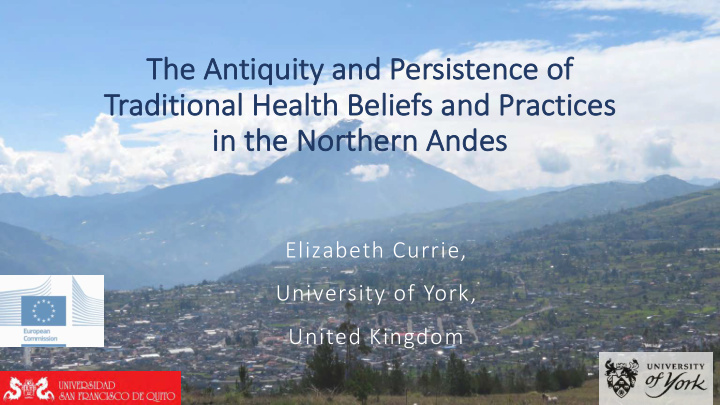



The The Anti tiqui quity ty and nd Per ersistenc ence e of Traditional Health Beliefs and Practices Tr in in th the e North ther ern Andes es Elizabeth Currie, University of York, United Kingdom
LONG TERM GOAL • Develop a conceptual ‘bridge’ from the study population to generate a trans-cultural model for use with peoples from migrant or marginalised backgrounds in contemporary global scenarios that informs best practice for the integration of their traditional beliefs into modern health and social care provision. • The development of this conceptual bridge will inform future policy making .
THE SCENARIO Population with an Contemporary historical global population ? experience of displacement trauma & change scenario
Central Andean ‘Health Axis’ Source: Bussman and Sharon 2006
Shamanistic ‘lore’ López Viejo, Manabí, Ecuador ca 1230 CE Ivory figurine of a harpy eagle-headed shaman in ‘soul flight’. López Viejo, coastal Ecuador
Moche pottery vessel showing a healer in the form of an owl (North Coast Peru, ca 300- 700CE)
Source: Marino and Gonzales-Portillo 2000
(AAL, Hechizerías y Idolatrías 3.2. Causa contra Juana Icha, 1650)
Study region: Ecuador ●Quito . Salasaca Quilotoa ● Guayaquil . Cuenca
• Archaeological: i) archaeological material culture (principally pottery and decorative motifs) demonstrating pre-Colombian beliefs and practices; ii) bio archaeological data from human remains; • Early colonial period Spanish documents which detail, through their own words, the beliefs, rites and practices of many of the indigenous religious specialists who found themselves before the ecclesiastical courts; • Ethnographic studies of the beliefs and practices of more recent historical or contemporary Amerindian peoples.
MODELLING HEALTH BELIEFS: CORE CONCEPTS EXPLORED
Curanderas and magical herbs, Cuenca market
Recent shaman’s ‘ mesas ’ (Cuenca Museum of Ethnography)
Yachak from Salasaca, Ecuador, performing a traditional ‘ limpieza’ ritual at the regional ‘ huaca’ Taita Punta Rumi
The General Conference of the United Nations Educational, Scientific and Cultural Organization hereinafter referred to as UNESCO, meeting in Paris, from 29 September to 17 October 2003, at its 32nd session, The “intangible cultural heritage … is manifested inter alia in the following domains: (a) oral traditions and expressions, including language as a vehicle of the intangible cultural heritage; (b) performing arts; (c) social practices, rituals and festive events; (d) knowledge and practices concerning nature and the universe; (e) traditional craftsmanship. “Safeguarding” means measures aimed at ensuring the viability of the intangible cultural heritage, including the identification, documentation, research, preservation, protection, promotion, enhancement, transmission, particularly through formal and non-formal education, as well as the revitalization of the various aspects of such heritage.
THANK YOU
ACKNOWLEDGEMENTS This project ‘MEDICINE. Indigenous concepts of health and healing in Andean populations. The relevance of traditional MEDICINE in a changing world’ is funded through the European Commission Horizon 2020 Research and Innovation programme. Grateful thanks are expressed to the Comunidades de Tingo Pucará, Guangaje and Salasaca, Ecuador for their hospitality and help during our early fieldwork visits. Thanks also to Dr Diego Quiroga, Universidad San Francsico de Quito, Ecuador and to Dr Fernando Ortega Perez, also of the Universidad de San Francisco de Quito, Ecuador, for their valuable contributions, insights and ideas.
Recommend
More recommend